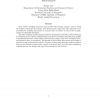Free Online Productivity Tools
i2Speak
i2Symbol
i2OCR
iTex2Img
iWeb2Print
iWeb2Shot
i2Type
iPdf2Split
iPdf2Merge
i2Bopomofo
i2Arabic
i2Style
i2Image
i2PDF
iLatex2Rtf
Sci2ools
124
Voted
ALT
1994
Springer
1994
Springer
Program Synthesis in the Presence of Infinite Number of Inaccuracies
Most studies modeling inaccurate data in Gold style learning consider cases in which the number of inaccuracies is finite. The present paper argues that this approach is not reasonable for modeling inaccuracies in concepts that are infinite in nature (for example, graphs of computable functions). The effect of infinite number of inaccuracies in the input data in Gold's model of learning is considered in the context of identification in the limit of computer programs from graphs of computable functions. Three kinds of inaccuracies, namely, noisy data, incomplete data, and imperfect data, are considered. The amount of each of these inaccuracies in the input is measured using certain density notions. A number of interesting hierarchy results are shown based on the densities of inaccuracies present in the input data. Several results establishing tradeoffs between the density and type of inaccuracies are also derived. 1
| Added | 09 Aug 2010 |
| Updated | 09 Aug 2010 |
| Type | Conference |
| Year | 1994 |
| Where | ALT |
| Authors | Sanjay Jain |
Comments (0)

